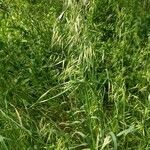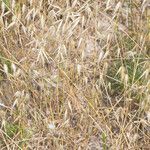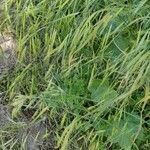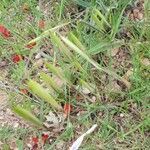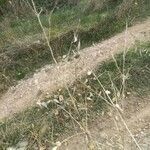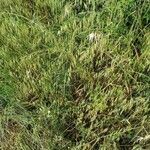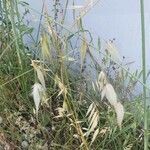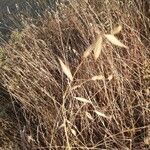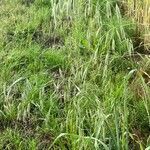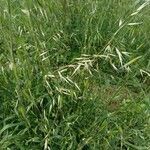Culms 35–125 (–160) cm high; mid-culm nodes exposed. Leaves mostly basal; ligule abaxially hairy; blade 12–30 (–45) cm long, 4–11 (–15) mm wide, acute, with midrib prominent. Panicles 7–27 cm long. Spikelets 18–25 (–30) mm long, with 2 or 3 bisexual florets; rachilla disarticulating between florets, silky. Glumes exceeding florets, 18–30 mm long, 7–9-nerved, with midnerve glabrous. Callus with hairs to 5 mm long. Lemma lanceolate, 16–22 mm long, bidentate to bisubulate or almost bilobed, 1-awned, 7 (–9)-nerved, scaberulous towards apex and silky below point of awn insertion; awn 18–48 mm long, arising from midpoint or lower half of lemma, with stout twisted column, geniculate. Palea slightly shorter than lemma, apically notched or shortly bidentate, membranous or sometimes slightly coriaceous, with keels wingless; nerves ciliate, with straight soft hairs to 0.4 mm long.
Annual. Culms erect or geniculate at base, 50–150 cm tall, unbranched, 2–4-noded. Leaf sheaths glabrous or basal sheaths puberulous; leaf blades 10–30 cm, 4–12 mm wide, scabrid or adaxial surface and margins pilose; ligule 1–5 mm. Panicle narrowly to broadly pyramidal, 10–40 cm, nodding; branches scabrid. Spikelets 1.7–2.5 cm, florets 2 or 3, all florets awned; rachilla easily disarticulating below each floret at maturity, each floret with a bearded callus, internodes hirsute or glabrous; glumes lanceolate, subequal, herbaceous, 9–11-veined, apex finely acute; callus hairs up to 4 mm; lemmas 1.5–2 cm, leathery, glabrous to densely hispid in lower half, green and scaberulous above, awned from near middle, apex shortly 2–4-toothed; awn 2–4 cm, geniculate, column twisted, blackish brown. Fl. and fr. Apr–Sep. 2n = 42.
Annual; culms 30–150 cm. high, erect or geniculate at the base, stout, simple.. Leaf-blades 10–45 cm. long and 3–15 mm. wide, glabrous, rough; ligules up to 6 mm. long.. Panicle nodding, narrowly to broadly pyramidal, 10–40 cm. long and up to 20 cm. wide, loose, with rough spreading branches.. Spikelets pendulous, 18–28 mm. long, 2–3-flowered, the rhachilla articulated beneath each floret; glumes lanceolate, finely acute; lemmas 14–20 mm. long, densely bearded around the horseshoe-shaped basal callus with hairs up to 4 mm. long, stiffly hairy and finally brown in the lower two-thirds, green and rough above, unequally and shortly 2–4-toothed at the apex; awn 2.5–4 cm. long, geniculate, the column dark brown.. Fig. 28, p. 83.
Stout annual to 10+ dm; ligules 2–6 mm; blades scabrous to somewhat pilose, 3–10(–15) mm wide; panicle 10–25+ cm, open, its branches horizontally spreading; spikelets ± nodding, (2)3-fld, the hirsute rachilla readily disarticulating; glumes prominently (7)9-or 11-veined, the first one 19–26+ mm, lanceolate, acuminate; lemmas 14–20+ mm, 5-or 7-veined, usually with brown hairs on the back, the 2 lower ones awned; awns (18–)28–45(–52) mm, stout, geniculate, twisted below, thin and tapering above, attached above the middle of the lemma; third lemma usually awnless; 2n=42. Native of Europe, frequently adventive or established as a weed of cult. ground or waste places, but not common in most of our range except at the nw.
Loosely tufted annual, 250-700 mm high; culms solitary. Leaf blade 50-280 x 3-8 mm; ligule an unfringed membrane. Inflorescence an open panicle. Spikelet 18-32 mm long, laterally compressed; glumes ± equal, 7-11-nerved, as long as to longer than spikelet. Florets 2 or 3; lemma 5-9-nerved, usually brownish in colour especially hairs, hairs loosely scattered; lobes usually 1.0-1.5 mm long, awnless; central awn longer than body of lemma, lower part twisted; palea shorter than lemma, densely, minutely hairy on both keels; callus present on all lemmas; anther 2.0-4.7 mm long. Flowering time Aug.-Nov.
Loosely tufted annual 250-700 mm high; culms solitary. Leaf blade 50-280 x 3-8 mm. Spikelet 18-32 mm long, 2-3-flowered; lemma usually brownish in colour especially the hairs, hairs loosely scattered; lobes usually 1.0-1.5 mm long, awnless, 1-nerved; palea shorter than the lemma, densely, minutely hairy on both keels; callus present on all lemmas; anther 2.0-4.7 mm long.
A stout, erect annual grass. It grows 1.2 m high. The stems are robust. The sheaths of the basal leaves are hairy. The leaves are flat and 45 cm long by 15 mm wide. The flowers are in heads up to 40 cm long. They are open and nodding. The awn is long (2.5-5 cm) and bent in the middle. The lower half is dark brown in each floret. The seed has a dense covering of hairs.
Lemmas 14-20 mm. long, 7-9-nerved, all awned, lanceolate or lanceolate-oblong, with the apex 2-4-dentate, stiffly pilose towards the base, scaberulous towards the apex, densely bearded at the insertion; awn up to 4.25 cm. long, inserted around the middle of the lemma, dark brown below, green or yellowish towards the apex.
Annual; 0.25-0.70 m high; solitary or loosely tufted. Leaf blades 50-280 x 3-8 mm. Flowers: panicle open; spikelets 18-32 mm long; brownish; specially on the hairs; lemmas densely hairy from base up to awn insertion; with lobes 1.0-1.5 mm long; central awn strongly geniculate.
Panicle 10-45 cm. long, up to 20 cm. in diameter, usually nodding, open and loose, pyramidal; branches usually clustered, rarely solitary (except the upper ones), spreading, filiform, loosely branched, scaberulous.
Annual, culms solitary or loosely tufted, up to 0.7 m high. Leaf blades 50-280 mm long, 3-8 mm wide. Spikelets 18-32 mm long, usually brownish, especially on hairs; lemma apices with teeth usually 1.0-1.5 mm long.
Leaf-laminae 10-50 x 0.3-1.6 cm., linear to lanceolate-linear, tapering to a fine point, expanded, vivid green, glabrous or rarely scattered pilose, scaberulous on both surfaces.
Culms 40-150 cm. tall, 3-5-noded, solitary, or in small tufts, simple, erect or ascending from a geniculate base, terete, smooth, usually glabrous.
Spikelets 18-30 mm. long, 2-3-flowered (with a reduced terminal floret), narrowly oblong to obtriangular-oblong in outline, gaping, pendulous.
Glumes equal to slightly unequal, 7-11-nerved, somewhat cross-veined, lanceolate, with the apex acute.
Caryopsis 6-8 mm. long, tightly enclosed between the hardened lemma and the palea.
Leaf-sheaths striate, dorsally rounded, the inferior often pilose, smooth.
Like A. barbata but lemma awnless and lemma teeth 1-1.5 mm long.
Ligule up to 6 mm. long, membranous, obtuse.
Palea densely ciliate along the keels.
Anthers c. 3 mm. long.
A weak annual.
